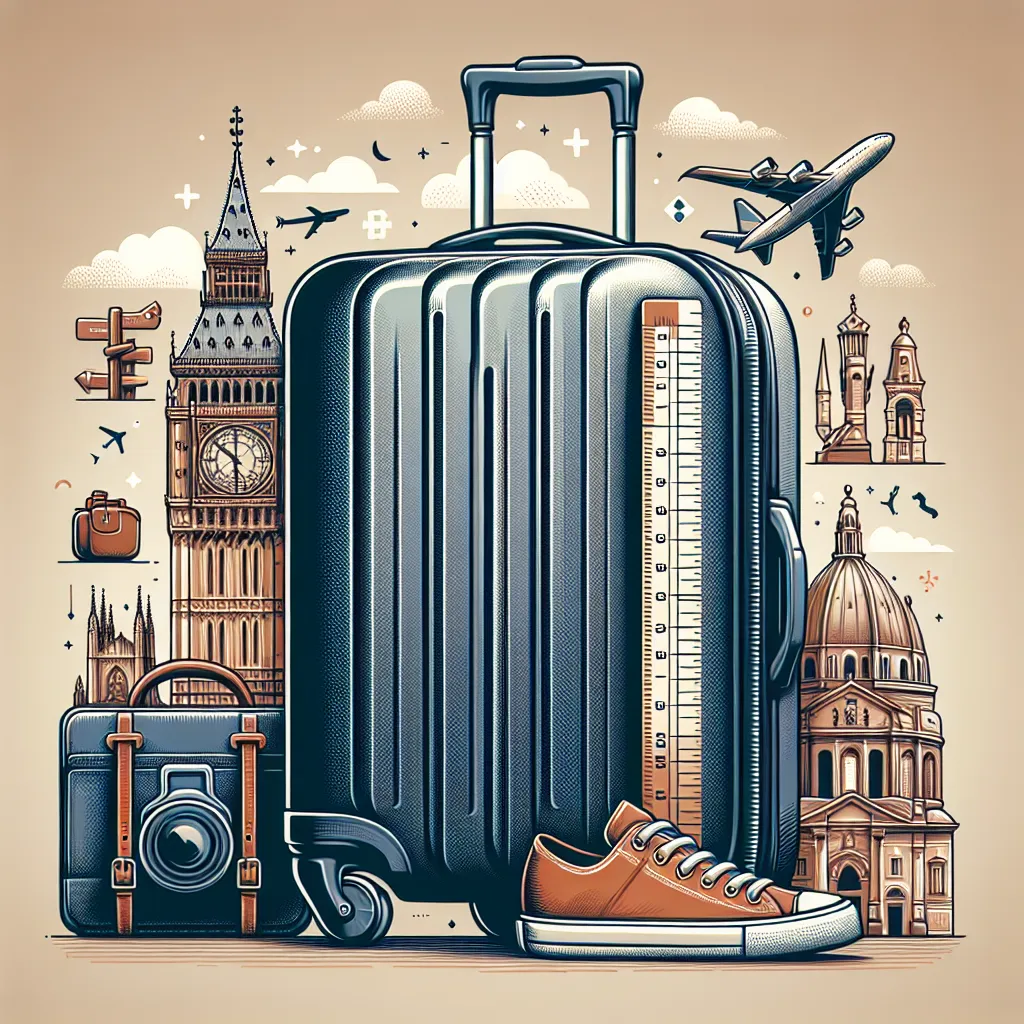Traveling to Europe can be an exciting adventure. But, it can also be a challenge, especially when it comes to packing.
Choosing the right luggage size is crucial. It can make the difference between a smooth journey and a stressful one.
This guide will help you navigate the complexities of selecting the best luggage size for ease of travel in Europe. We'll consider factors like the duration of your trip, the type of travel, and the transportation methods you'll be using.
We'll also delve into the strict baggage policies of European airlines. And, we'll explore the benefits of different luggage types, from carry-on bags to medium-sized suitcases.
Whether you're a first-time visitor or a seasoned traveler, this guide will provide practical advice to make your European journey as hassle-free as possible.
So, let's embark on this journey to find the best luggage size for your European adventure.
Understanding European Travel Requirements
Traveling across Europe is unique, thanks to its diverse culture and compact geography. Understanding travel requirements is key to choosing the right luggage size. Consider the mode of transport you'll frequently use.
European trips often involve a mix of flights, trains, and public transport. Each has different baggage requirements and size restrictions. Being mindful of these can prevent unexpected fees and hassles.
Packing for Europe also involves considering the variety of destinations. From bustling cities to serene countryside, each locale may present different luggage challenges. Opt for versatile luggage to adapt to these environments.
Here are some points to keep in mind:
- Check size and weight restrictions for each mode of transport
- Be prepared for cobblestone streets and stairs with lightweight luggage
- Flexibility is key when traveling through multiple regions
Having a fundamental understanding of these requirements can make the decision-making process smoother.
Airline Baggage Policies
When traveling by air, knowing airline baggage policies is vital. European airlines are known for their strict luggage regulations, especially budget carriers. Many carriers enforce limits on both size and weight.
Typically, carry-on luggage shouldn't exceed 55x40x20 cm. This ensures it fits in overhead compartments. Weight limits generally range around 8-10 kg, although this varies by airline. Research policies beforehand to avoid check-in lines and extra fees.
Consider purchasing a reliable luggage scale. This can help you stay within weight limits, ensuring a trouble-free journey. Planning ahead is essential, as different airlines may have varying allowances.
Train and Public Transport Considerations
Traveling by train offers a comfortable way to see Europe, yet it presents its own luggage challenges. Most European trains have luggage storage areas, but space can be limited. Smaller, compact luggage can make navigating trains easier.
Public transportation, such as buses and trams, often have even stricter space constraints. Maneuverability is important, as these vehicles are often crowded, particularly in major cities.
Be mindful of luggage size and ensure it can easily be lifted onto racks or stored below seats. Lightweight and durable luggage is preferable when using public transport. Being prepared can ensure a smooth transition from one destination to the next.
The Ideal Luggage Size for European Travel
Choosing the right luggage size is crucial for smooth travels in Europe. The ideal size depends on various factors, including trip duration, activities planned, and transportation. A strategic choice can greatly enhance your travel experience.
One size does not fit all for European adventures. Here are general guidelines to consider:
- For short trips (3-5 days): Opt for carry-on luggage
- For longer stays or multiple destinations: A medium-sized suitcase might be better
- For day trips: A compact daypack is ideal
Carry-on luggage is a popular choice for its portability and ease of access. It allows you to avoid the hassle of baggage checks. However, it can be limiting in terms of packing space.
For travelers planning extended stays, medium-sized suitcases provide more room. They allow for extra items, like souvenirs or additional clothing. These suitcases strike a balance between size and capacity, making them versatile.
Carry-On Luggage: Pros and Cons
Carry-on bags are favored for their convenience. They eliminate baggage wait times, allowing travelers to exit the airport swiftly. This expedites moving from flight to public transport or rental car pickup.
A major advantage is avoiding checked baggage fees, which can add up quickly. Traveling light can also make navigating cobblestone streets and stairs less daunting.
However, carry-ons have limitations. Their smaller size might mean omitting some travel essentials. Travelers must pack efficiently, making smart choices about what is truly necessary. Despite the compact nature, carry-ons can often suffice with careful planning.
Medium-Sized Suitcases for Extended Stays
Medium-sized suitcases shine for longer European journeys. Offering more storage, they accommodate the needs of extended travelers. Packing for varying climates becomes possible, allowing for flexibility in attire choices.
These suitcases are a middle-ground option. They are larger than carry-ons but still manageable for solo transport. Having extra room is handy for unforeseen purchases or souvenir collection.
Despite their advantages, they might be cumbersome on local transport. Ensuring maneuverability is crucial, so opt for suitcases with sturdy wheels and handles. Choose designs that are durable and lightweight to ease the journey.
Daypacks and Bags for Day Trips
For city exploration or short excursions, daypacks offer excellent practicality. They are compact and lightweight, making them ideal for carrying essentials. Daypacks can easily fit in buses, trams, or small rental lockers.
They are designed for comfort and utility. Features like padded straps and multiple compartments enhance usability. Essential travel documents, snacks, and a water bottle fit comfortably.
However, choose wisely based on your day trip activities. A too-small bag may feel restrictive, while larger options might become burdensome. Opt for something that balances capacity with ease of use. A well-chosen daypack significantly improves daily explorations.
Packing Smart: Tips and Tricks
Packing efficiently is an art form that enhances travel experiences. Mastering this skill allows travelers to carry less and enjoy more. A streamlined approach can relieve travel stress and enhance mobility.
Focus on versatile clothing that can be mixed and matched. This reduces the number of items needed while still keeping options open. Prioritize lightweight and wrinkle-resistant materials for ease of wear.
Organizing items is vital for optimizing luggage space. Use compression bags or packing cubes to separate and compact clothes. This technique maximizes the room and helps maintain order.
Consider the following smart packing tips for your European adventure:
- Roll clothes instead of folding to save space
- Use shoes to store small items like socks or chargers
- Pack toiletries in reusable travel-size containers
- Carry a small first-aid kit for minor emergencies
- Leave some space for souvenirs or unexpected purchases
Efficient Packing Techniques
Rolling clothes is a simple yet effective method for saving luggage space. This technique minimizes wrinkles and optimizes available packing room. It also makes finding items easier once the suitcase is opened.
Layering clothing is another efficient method to prepare for varied European climates. Carry a few lightweight layers that can be worn in different combinations. This approach allows adaptability to weather fluctuations without overpacking.
Opt for dual-use items whenever possible. Travel-size laundry detergent can allow for washing clothes during longer stays. This reduces the amount of clothing needed, alleviating the load on your luggage.
Must-Have Travel Accessories
Several accessories can improve your travel organization and comfort significantly. Packing cubes, for instance, help compartmentalize your belongings. This separation keeps clothes organized and simplifies access.
A reusable water bottle is a travel essential. Staying hydrated is crucial, especially during long days of exploration. Many European cities have public fountains, making refills convenient and free.
Don’t forget about travel locks to secure your belongings. Small locks can protect your luggage in crowded areas. Combined with luggage tags, they ensure you can identify and safeguard your bags swiftly.
Choose travel accessories that cater to your personal needs. This approach guarantees that your journey is comfortable and worry-free. Customize your packing list to suit the nature and duration of your trip.
Luggage Features for Comfort and Convenience
Choosing the right luggage comes down to its features. These features can greatly influence your travel experience. Prioritizing comfort and convenience ensures stress-free journeys.
Look for luggage with ergonomic handles. Padded handles reduce the strain on your hands and wrists. Adjustable straps are beneficial for backpacks, providing better weight distribution.
Consider wheels that enhance maneuverability. Multi-directional spinner wheels offer smooth and easy movement. This feature is particularly useful in busy airports and crowded train stations.
When selecting luggage, pay attention to its fabric and construction. Water-resistant or durable materials can withstand the elements and rough handling. Ensure your luggage is both lightweight and robust for maximum ease of travel.
Here are key comfort and convenience features to look for:
- Ergonomic, telescopic handles that extend and retract smoothly
- Multi-directional spinner wheels for effortless navigation
- Spacious compartments with expandable capacity
- Durable and weather-resistant material
- Lightweight design for easy lifting and carrying
Maneuverability and Durability
Navigating through Europe requires agile luggage. Maneuverability can make your travel smoother and less tiring. Lightweight luggage with quality wheels is essential for this purpose.
Multi-directional spinner wheels simplify movement through tight spaces. These wheels rotate 360 degrees, allowing for easy direction changes. This is especially helpful in narrow corridors and busy transport hubs.
Durability is a critical consideration when choosing luggage. It needs to withstand the rigors of travel without compromising its integrity. Look for high-quality materials like polycarbonate or ballistic nylon that offer strength and resilience.
Robust luggage can endure various travel demands. From rough handling at airports to unpredictable weather conditions, durability is key. A well-constructed suitcase provides peace of mind and longevity.
Security and Protection
Traveling through Europe necessitates security. Ensuring your belongings are safe is paramount. Good luggage should come equipped with features that deter theft and protect your items.
Consider opting for luggage with built-in locks. TSA-approved locks provide security and ease of access for inspections. They keep your belongings secure while allowing authorized checks.
Protective compartments add an extra layer of safety. Padded sections for electronics guard against impact damage. Reinforced zippers also minimize the risk of break-ins.
Luggage protection doesn’t end with security features. Weather-resistant materials shield your belongings from rain or snow. It's wise to select a suitcase that offers both protection and durability against the elements.
Incorporating protective features in your luggage choice is wise. These features ensure your items remain safe throughout your travels. Invest in luggage that combines security with reliable protection methods.
Final Thoughts: Balancing Size, Style, and Functionality
Choosing the best luggage size for travel in Europe is a balancing act. It requires thoughtful consideration of size, style, and functionality. Each aspect plays a crucial role in creating a pleasant travel experience.
Size influences mobility and convenience, particularly in Europe's bustling cities. Opt for luggage that accommodates your needs without being cumbersome. Smaller, versatile bags are often the ideal choice for navigating through narrow streets and busy transit systems.
Meanwhile, personal style adds a touch of individuality to your travel gear. However, it should not compromise practical features. Selecting luggage that reflects your taste while offering essential functions is key.
Functionality includes organization, security, and comfort features that enhance travel ease. Luggage should meet both practical requirements and suit your aesthetic preferences. Strive for a balance that achieves comfort, safety, and style, making your European adventures truly enjoyable.



